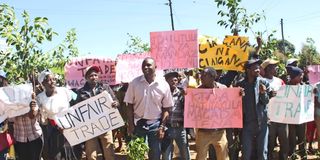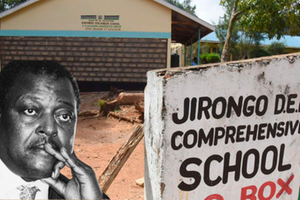Premium
The golden years of KTDA and when rain started beating it

Farmers hold protests outside Gitugi Tea Factory in Nyeri County. They had boycotted tea picking over low bonus payout by the Kenya Tea Development Authority.
What you need to know:
- Like other public agricultural enterprises, including the Coffee Board of Kenya, the Pyrethrum Marketing Board, and the sugar companies (Mumias and Nzoia), KTDA was expected to operate under the following principles laid down by the government: efficiency, financial solvency and commercial viability.
- The 1979 Ndegwa Committee on the Review of Statutory Boards reported “clear evidence of prolonged inefficiency, financial mismanagement, waste and malpractices”.
- The advent of the world recession in the late 1980s once more led to a decline in Kenya’s agricultural performance, which also affected the tea sub-sector.
- In April, the government promulgated the Crops (Tea Industry) Regulations to solve these problems. It intends to do this through regulating and controlling activities that have hitherto been performed by the agency.
As Kenya’s independence approached, the colonial government decided to incorporate African smallholders in tea production.
In line with the broad aim of the 1954 Swynneton Plan to develop a class of progressive African farmers, the colonial state established the Special Crop Development Authority (SCDA) in 1960.
The SCDA was placed under the Department of Agriculture to emphasize the importance that was attached to the tea industry.
During the early years of independence, there were struggles between African tea growers and the British-based multinational firms like Brooke Bond, which controlled tea marketing through the Kenya Tea Packers (Ketepa).
The multinationals had controlled tea growing and marketing during the colonial period as oligopolies.
Kenya’s independence in 1963 and its leaders’ nationalistic ethos would alter this situation. In 1964, a year after independence, the Kenya Tea Development Authority (KTDA) was established as a parastatal.
African smallholders were more fully incorporated in it as tea growers and members. More Africans were elected to the authority’s board. Its role was to foster and promote commercial tea growing among smallholder Africans.
Like other public agricultural enterprises, including the Coffee Board of Kenya, the Pyrethrum Marketing Board, and the sugar companies (Mumias and Nzoia), KTDA was expected to operate under the following principles laid down by the government: efficiency, financial solvency and commercial viability.
Its performance during the first decade of independence was satisfactory. Tea production increased following the rise in the number of smallholder growers and the global tea price boom.
These were KTDA’s days of grandeur. Unfortunately, the authority’s fortunes, alongside those of other public enterprises, began to change for the worse in late 1970s.
The newly established Moi government set up a committee to investigate the reasons for their poor performance.
The 1979 Ndegwa Committee on the Review of Statutory Boards reported “clear evidence of prolonged inefficiency, financial mismanagement, waste and malpractices”.
More specifically, the committee emphasized “the low rate of return on investments in public enterprises”. It further pointed out that there was appointment of inefficient directors and senior staff, improper financial control procedures, under-capitalisation and ineffective government supervision.
Although these weaknesses led to changes in KTDA’s management, the government came to its rescue by issuing subsidies and establishing some control measures.
Key role
But by focusing on corrupt and inefficient managers and replacing them, the government ignored the primary factors that ailed the authority.
These are recurrent world recessions that were partly caused by oil crises, the rise in the price of agricultural inputs such as fertilisers, and the poor terms of trade of agricultural commodities including tea.
The problems facing KTDA, therefore, persisted. The advent of the world recession in the late 1980s once more led to a decline in Kenya’s agricultural performance, which also affected the tea sub-sector.
A Working Committee on Government Expenditure in 1982 reiterated poor financial performance. So did inefficient and corrupt management, huge government subsidies and vicious struggles between the authority and government.
The last led to the establishment of the Nyayo Tea Zones in 1986 as President Daniel arap Moi’s counterpoise under the guise of environmental conservation.
More significantly, the establishment of the Nyayo Tea Zones illustrated the intervention of power politics in agriculture, which did not necessarily end with the Moi regime.
One more time, the government focused on secondary rather than primary causes of the problems that faced KTDA and the tea industry.
Because of the key role tea played in the country’s economy, the government readily resorted to subsidising the ailing KTDA before it was forced by the World Bank and donor countries’ conditionalities under Structural Adjustment Programs (SAPs) to privatise it.
The Kenya government implemented SAPs through its Sessional Paper No. 1 of 1986 on Economic Management for Renewed Growth.
This drastically reduced subsidies to KTDA and other parastatals. The little funds that were available and the earnings from tea exports kept the authority alive through the 1990s without the government privatising it at the time.
In July 2000, however, the policy of privatisation was intensified in the tea industry with the establishment of the Kenya Tea Development Agency.
The agency arrogated to itself a very wide range of responsibilities that include managing smallholder tea cultivation; collecting, weighing, handling and paying tea growers for deliveries; manufacturing green tea leaf into tea, marketing the manufactured tea; providing the requisite financial, managerial and technical and other infrastructure and all many other support services.
Solve the problems
The agency has achieved a lot but also faced a number of challenges over the last twenty years.
To discharge the multitude of responsibilities to over half a million smallholders and over 50 tea factories spread across the country, the agency established many units and subsidiary companies.
They performed the following roles: packaging, warehousing, insurance, property management, power generation, and fabrication of machinery.
Its positive achievements include the establishment of many more efficiently run tea farms, successful sale of tea to traditional and new destinations and diversification of types of tea.
Challenges cropped up, including irregular, fraudulent and occasionally violent elections of its directors; illegal awards of contracts to directors for the supply of a variety of items, financial problems leading to delays in paying smallholders and poor marketing including faulty tea auctions at Mombasa.
In the words of CS Peter Munya, the agency’s marketing system is “characterised by lack of transparency, accountability and competition and is prone to manipulation, capture, insider trading and cartelisation by value chain players”.
In April, the government promulgated the Crops (Tea Industry) Regulations to solve these problems. It intends to do this through regulating and controlling activities that have hitherto been performed by the agency. The results of these control mechanisms remain to be seen.
Equally important is whether the State intervention adequately reconciles the interest of all the stakeholders in the tea industry. Has the state been an impartial arbiter in the whole saga? Time will tell.





